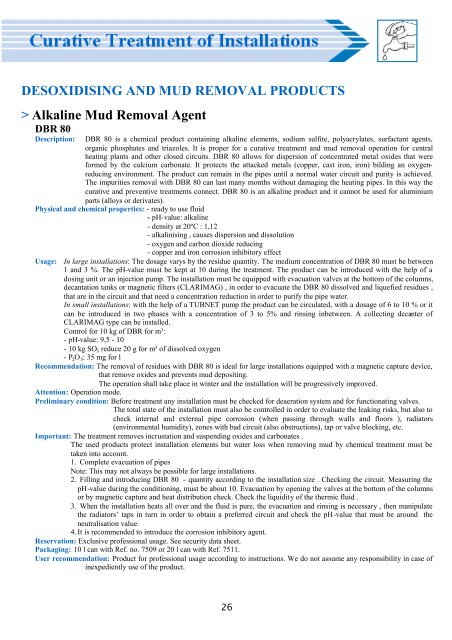pump body of PPH - Progalva
pump body of PPH - Progalva
pump body of PPH - Progalva
You also want an ePaper? Increase the reach of your titles
YUMPU automatically turns print PDFs into web optimized ePapers that Google loves.
DESOXIDISING AND MUD REMOVAL PRODUCTS<br />
> Alkaline Mud Removal Agent<br />
DBR 80<br />
Description: DBR 80 is a chemical product containing alkaline elements, sodium sulfite, polyacrylates, surfactant agents,<br />
organic phosphates and triazoles. It is proper for a curative treatment and mud removal operation for central<br />
heating plants and other closed circuits. DBR 80 allows for dispersion <strong>of</strong> concentrated metal oxides that were<br />
formed by the calcium carbonate. It protects the attacked metals (copper, cast iron, iron) bilding an oxygenreducing<br />
environment. The product can remain in the pipes until a normal water circuit and purity is achieved.<br />
The impurities removal with DBR 80 can last many months without damaging the heating pipes. In this way the<br />
curative and preventive treatments connect. DBR 80 is an alkaline product and it cannot be used for aluminium<br />
parts (alloys or derivates).<br />
Physical and chemical properties: - ready to use fluid<br />
- pH-value: alkaline<br />
- density at 20ºC : 1,12<br />
- alkalinising , causes dispersion and dissolution<br />
- oxygen and carbon dioxide reducing<br />
- copper and iron corrosion inhibitory effect<br />
Usage: In large installations: The dosage varys by the residue quantity. The medium concentration <strong>of</strong> DBR 80 must be between<br />
1 and 3 %. The pH-value must be kept at 10 during the treatment. The product can be introduced with the help <strong>of</strong> a<br />
dosing unit or an injection <strong>pump</strong>. The installation must be equipped with evacuation valves at the bottom <strong>of</strong> the columns,<br />
decantation tanks or magnetic filters (CLARIMAG) , in order to evacuate the DBR 80 dissolved and liquefied residues ,<br />
that are in the circuit and that need a concentration reduction in order to purify the pipe water.<br />
In small installations: with the help <strong>of</strong> a TUBNET <strong>pump</strong> the product can be circulated, with a dosage <strong>of</strong> 6 to 10 % or it<br />
can be introduced in two phases with a concentration <strong>of</strong> 3 to 5% and rinsing inbetween. A collecting decanter <strong>of</strong><br />
CLARIMAG type can be installed.<br />
Control for 10 kg <strong>of</strong> DBR for m³:<br />
- pH-value: 9,5 - 10<br />
- 10 kg SO 3 reduce 20 g for m³ <strong>of</strong> dissolved oxygen<br />
- P 2O 5: 35 mg for l<br />
Recommendation: The removal <strong>of</strong> residues with DBR 80 is ideal for large installations equipped with a magnetic capture device,<br />
that remove oxides and prevents mud depositing.<br />
The operation shall take place in winter and the installation will be progressively improved.<br />
Attention: Operation mode.<br />
Preliminary condition: Before treatment any installation must be checked for deaeration system and for functionating valves.<br />
The total state <strong>of</strong> the installation must also be controlled in order to evaluate the leaking risks, but also to<br />
check internal and external pipe corrosion (when passing through walls and floors ), radiators<br />
(environmental humidity), zones with bad circuit (also obstructions), tap or valve blocking, etc.<br />
Important: The treatment removes incrustation and suspending oxides and carbonates .<br />
The used products protect installation elements but water loss when removing mud by chemical treatment must be<br />
taken into account.<br />
1. Complete evacuation <strong>of</strong> pipes<br />
Note: This may not always be possible for large installations.<br />
2. Filling and introducing DBR 80 - quantity according to the installation size . Checking the circuit. Measuring the<br />
pH-value during the conditioning, must be about 10. Evacuation by opening the valves at the bottom <strong>of</strong> the columns<br />
or by magnetic capture and heat distribution check. Check the liquidity <strong>of</strong> the thermic fluid .<br />
3. When the installation heats all over and the fluid is pure, the evacuation and rinsing is necessary , then manipulate<br />
the radiators’ taps in turn in order to obtain a preferred circuit and check the pH-value that must be around the<br />
neutralisation value.<br />
4. It is recommended to introduce the corrosion inhibitory agent.<br />
Reservation: Exclusive pr<strong>of</strong>essional usage. See security data sheet.<br />
Packaging: 10 l can with Ref. no. 7509 or 20 l can with Ref. 7511.<br />
User recommendation: Product for pr<strong>of</strong>essional usage according to instructions. We do not assume any responsibility in case <strong>of</strong><br />
inexpediently use <strong>of</strong> the product.<br />
26



